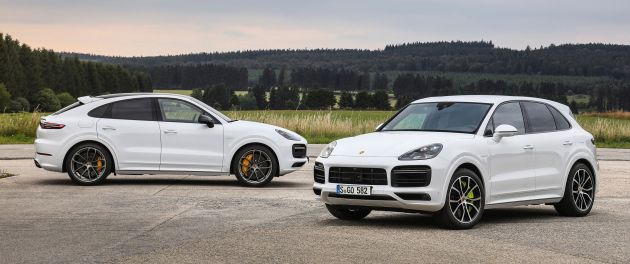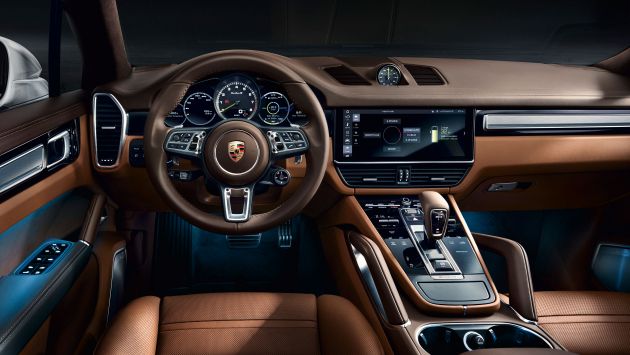When it comes to electrification, Porsche puts its money where its mouth is. The company has revealed the most powerful versions of the latest Cayenne and Cayenne Coupé, and they’re both plug-in hybrids – the Turbo S E-Hybrid, to be exact.
As the name suggests, the SUVs inherit their powertrains from the Panamera Turbo S E-Hybrid, in this case a 4.0 litre twin-turbocharged V8 that develops 550 PS and 770 Nm of torque. So far, so Cayenne Turbo, but Zuffenhausen has also thrown in a 136 PS/400 Nm electric motor on top of that, sandwiched between the petrol mill and an eight-speed Tiptronic automatic transmission.
Predictably, the total figures are stratospheric. Power has jumped to 680 PS from 5,750 to 6,000 rpm, while maximum torque stands at a towering 900 Nm, made between 1,500 to 5,000 rpm. This enables the Cayenne – which now weighs just a sliver under two and a half tonnes (2,535 kg for the Coupé) – to sprint from zero to 100 km/h in 3.8 seconds and onward to 200 km/h in 13.2 seconds, before hitting a top speed of 295 km/h.
Of course, a plug-in hybrid is also supposed to be efficient, and with a 14.1 kWh lithium-ion battery, both models are capable of a combined fuel consumption figure of between 3.7 to 3.9 litres per 100 km on the NEDC cycle, as well as an all-electric range of up to 40 km.
Electric power can be used to propel the car on its own in E-Power mode at speeds of up 135 km/h, or used to assist the engine in the Hybrid Auto, Sport and Sport plus modes. These drive modes can be selected using a rotary switch on the steering wheel, thanks to the standard-fit Sport Chrono Package.
Situated under the boot floor, the battery can be fully charged in six hours using a 230-volt, 10-ampere domestic socket, or 2.4 hours through an AC charging station, using the standard 7.2 kW onboard charger. Owners can schedule charging via either the Porsche Communication Management (PCM) infotainment system or the Porsche Connect app for smartphones and the Apple Watch.
To make sure that the Turbo S E-Hybrid models handle on rails, the cars come as standard with Porsche Dynamic Chassis Control (PDCC) electric roll stabilisation, Porsche Torque Vectoring Plus (PTV Plus) locking rear differential, Porsche Ceramic Composite Brake (PCCB), 21-inch aero alloy wheels, Power Steering Plus and adaptive three-chamber air suspension with Porsche Active Suspension Management (PASM) dampers.
They are also fitted with online navigation with real-time traffic information, smart online voice control and a suite of Porsche Connect services that include a search function for public charging stations. Auxiliary air-conditioning, controlled through the PCM and the Porsche Connect app, is also offered, along with options such as 22-inch alloy wheels and rear-wheel steering.
As part of a model year update, Porsche has also reintroduced the Cayenne E-Hybrid, now also offered in Coupé form. This uses a less powerful 3.0 litre turbo V6, now fitted with a particulate filter; nevertheless, it still develops a total system output of 462 PS and 700 Nm, allowing it to go from zero to 100 km/h in five seconds flat and hit a top speed of 253 km/h.
On the flip side, it also delivers a combined fuel consumption figure of 3.1 to 3.2 litres per 100 km and has an all-electric range of up to 43 km. The 2020 update also adds a few options for the rest of the Cayenne range, including wireless Apple CarPlay connectivity, USB-C ports and wireless smartphone charging.
-paultan









Tinggalkan komen anda